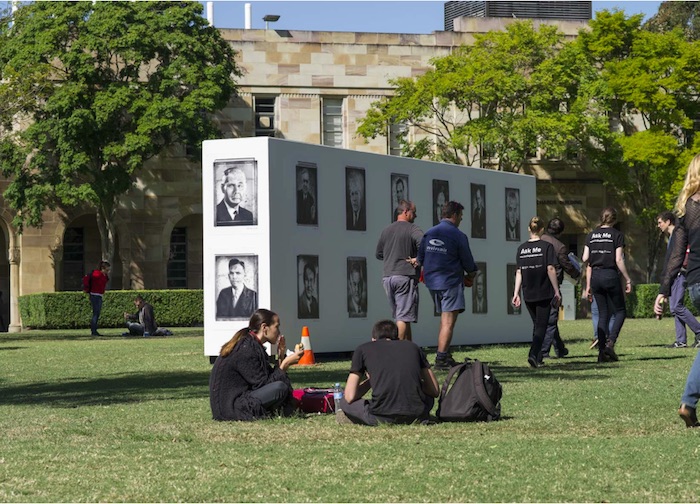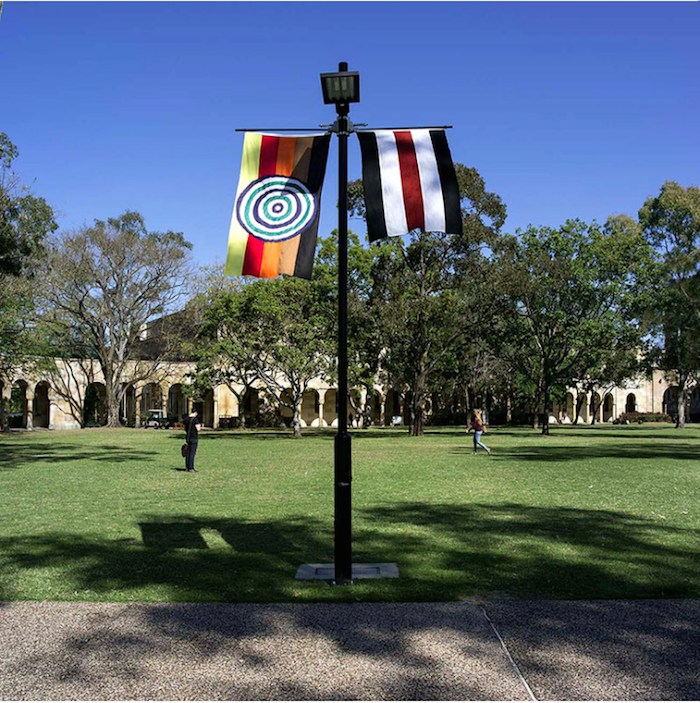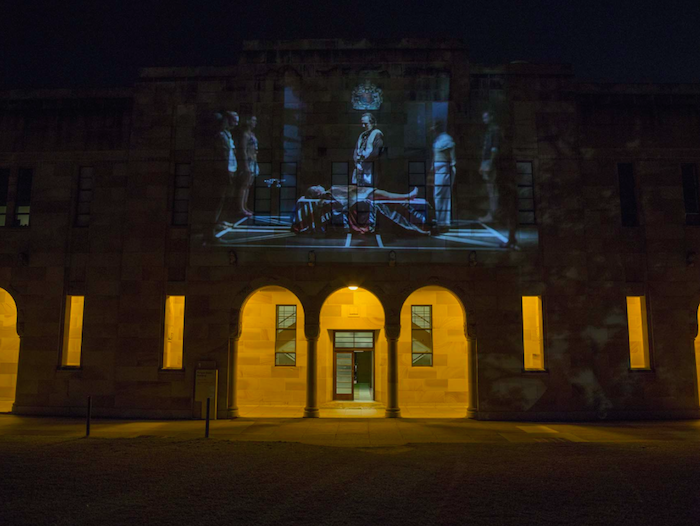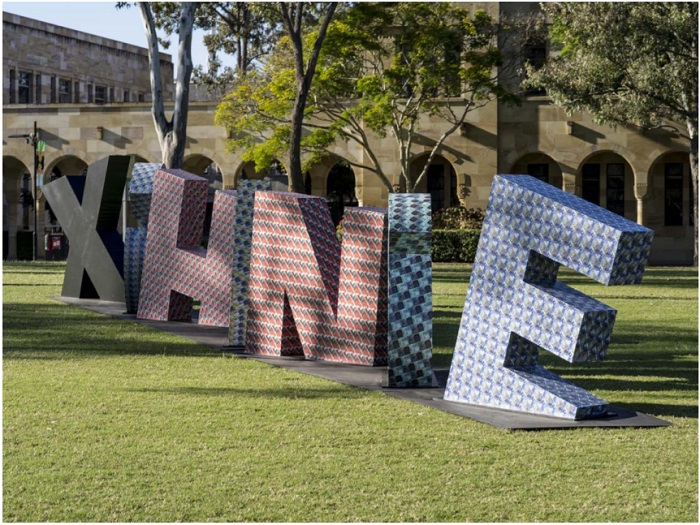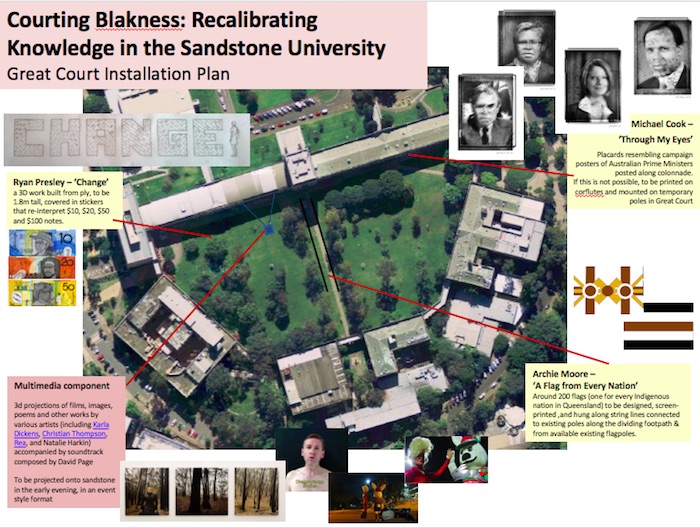AustLit
-
This project produced original art and high-quality research to advance knowledge relationships between Indigenous and non-Indigenous people. A cornerstone of the project was a public art installation at The University of Queensland’s Great Court. It was designed by leading Aboriginal artists with the aim of creating an integrated arts-led transformative education and research platform, where dialogue could occur across social, political and cultural boundaries around a range of critical issues.
-
The project was led by a diverse team of artists and academics with longstanding records of working across Indigenous and mainstream Australian cultures. Project outcomes in discovery, learning and community engagement significantly advanced the task of recalibrating the relationship between Indigenous people and universities for the 21st Century.
-
The installation featured a series of on-site and social networking platforms that provided opportunities for various target groups – such as UQ students and academics, visitors, and online participants – to actively engage the artworks and each other. The research component culminated in an international symposium and related high-quality publications that brought together Indigenous and non-Indigenous academics, artists and practitioners.
-
Before the installation was demounted a digital visualisation of the works on site was created and linked to a mobile phone application and website so that visitors could continue to experience the project’s creative inscription on the Great Court.
Artwork images, from top: Through My Eyes by Michael Cook; 14 Nations by Archie Moore; The Blaktism by Megan Cope; and, Debt by Ryan Presley. Photos by Carl Warner.
-
by John East
In August 1936, when Jack F. Hennessy was still developing his plans for the new campus at St Lucia, he stressed the need for “a national note in Australian architecture” and declared that his design for the new university “would convey something of the spirit of the pioneers, the A.I.F., the men who tilled the soil and rode the plains.” But of course he realised that this was not enough: “Having struck this national note in a strong, symbolic way, it might be desirable to include some of the detail of the old classical forms, or something typical of English architecture.”
Clearly the new University was intended to be more than just a collection of buildings. It was intended as a monument, a cultural artefact, and a national symbol. It would achieve this objective partly by its sheer size and its hill-top location, but artworks (especially sculpture) would also play an important role.
Fortunately the Great Court offered ample spaces for the public display of art. Cornice friezes were carved around the Tower and above the entrances. The tall openings in the Tower, which was to house a carillon of bells, contained sculpted pierced-stone panels (later demolished). The arches around the main entrances were adorned with sculptures, and the capitals of each of the cloister columns were carved with the coats of arms of other universities. Large sculptures of major figures in the history of the arts and sciences flank the principal entrances. Corbels were placed on the walls around the Great Court to support the grotesques (“gargoyles”) which have become the most admired of the sculptures.
Internally, the buildings also offered monumental spaces suitable for artistic display. The Great Hall, intended to stand where the Michie Building is now located, was to have a ceiling decorated in motifs from Aboriginal rock art. It was never built, but the Library reading room was topped by a glass ceiling (later demolished), etched with Aboriginal motifs. Murals were painted for the walls of the Geology Building and above the Arts stairwell in the Main Building. However the bronze doors and carved panels planned for the foyer of the Main Building fell victim to cost-cutting.
Although Hennessy proposed a reflecting pool in front of the Tower (outside of the Great Court), water features did not play a major role in his plans. The fountains which have subsequently appeared on the periphery of the Great Court are the work of later designers.
When he revealed his final plans, Hennessy explained that “the buildings should inculcate culture and refinement as much as any of the lectures.” Clearly then the artworks which adorned them would have a distinctly didactic role. The cornice friezes include scenes from the history of white Australia, the development of its industries, the Australian involvement in World War II and the foundation of the University. The large sculptured figures are all of celebrated dead white males. The sculptures of Australian flora and fauna provide an object lesson in antipodean natural history.
It is the numerous sculptures on Aboriginal themes which are the most intriguing. It can be argued that they do nothing but reduce Australia’s first inhabitants to one more natural curiosity, like the sugar gliders, bandicoots and eucalypts depicted in other sculptures. And yet Jack F. Hennessy had a genuine interest in Aboriginal culture and art, something which is hard to explain in an Australian man of distinctly conservative political, religious and social views, born when Queen Victoria was still on the throne.
The University authorities certainly did not share Hennessy’s passion for things Aboriginal. After the architect had commissioned the painter Arthur Murch to execute a mural of the Molonga corroboree for the Arts stairwell, the academics protested when Murch presented a design for a mural depicting scenes of daily Aboriginal life for the Law stairwell. “These activities … have already been carved in stone in thirty (30) panels on the exterior walls” they wrote in obvious exasperation. They proposed instead “processional groups of the great figures of literature, statesmanship, philosophy, law,” or, in other words, more dead white males.
John East worked for 30 years in the University of Queensland library. He has recently completed an architectural history of the Great Court and his Biography of Jack Hennessy, a preprint of an article which will appear in the 2014 issue of Fryer Folios, can be viewed here.
-
This is an edited version of an essay by Ashley Kerrison
Rhyl Hinwood is a sculptor, an artist who carves Helidon freestone to reveal delicate and detailed artworks. If you take a walk through the Great Court to the outside of the Michie building make sure to look up. All around you in this great space there are intricate carvings, an abundance of information, a celebration of the achievements of staff and graduates of the University and a record of the history of the State of Queensland carved into the walls.
Rhyl was first commissioned in 1976 as the second sculptor for the University of Queensland. Clive Moore suggests that the construction of the Great Court was “a deliberate statement about the nature of the state and the centrality of education” (2011:33). The suburb of St. Lucia itself is situated on a boundary between the lands of the Turrbal and Jagera Aboriginal peoples. The Great Court will host a large-scale Aboriginal art project on the land between the 5-28th of September. This project, Courting Blakness, investigates how Aboriginal representation and history is contextualised into a story with many different perspectives.
Since the time of Rhyl’s initial work, representations of Aboriginal culture have increased immensely, partly due to her interest in and commitment to the inclusion of Indigenous culture in the Great Court.
When gazing up into the faces and sculptures around the Michie building, looking back down you will see two Aboriginal faces. The first is Willie Mackenzie whose Aboriginal name is Gaiarbau. He belonged to the Jinibara people. Inclusion of Willie’s grotesque portrait represents the important role Aboriginal people play in understanding the natural world and how a culture that is so diverse needs to be documented to be preserved and to educate. Rhyl has included the native bee underneath Willie, which is the totem for the Jinibara people and he is carved holding clap sticks as his symbolic element. The second figure is an Aboriginal woman intended to represent all indigenous women and the naked beauty of Mother Earth. Her hands speak to us in Aboriginal sign language; “I hear my people singing and dancing at the corroboree”.
Along the arches are carved native Queensland fauna that represent the suburbs of Brisbane named in the local Aboriginal tongue. These include the echidna of Mt Gravatt, the water dragon of Moggill and the long necked tortoise that is Pinkenba. The vehicular entrance to Chancellors Place is framed with nomadic and migratory birds, which are all Queensland’s principal fauna. Rhyl says that the motivation behind the bird arch is how the birds are symbolic of the students who like the birds are migratory and nomadic, travelling overseas to study and moving from state to state after the completion of their studies at UQ.
Including subjects ranging from bush tucker to the diverse fauna that inhabits Queensland, Rhyl also carved the cloister archon the Michie building, representing the species that Indigenous people used for food, the making of implements and for medicinal purposes. This suite of carvings included the bunya nut, orchid, cycad, banksia, grasstree, lillipilly, mangroves and pandanus tree. Other food sources represented are the giant wood moth, the witchetty grub, ships’ worm and Pipis.
Just by understanding this small survey of native bush tucker and the flora and fauna of Queensland it can be seen that Rhyl has provided UQ with a library carved in stone. This ties back into the theme of Courting Blakness as a driver for the recalibration of knowledge, providing an abundance of information in a subtle way. Thus UQ can thank Willie Mackenzie and the UQ Anthropology museum for providing such detailed and vast information about Aboriginal people and their way of life. Gratitude to Rhyl must also be extended as she proposed and created a visual library full of symbolism and knowledge upon the walls of UQ.
References
Moore, C. 2011, ‘The Forgan Smith Building and the Great Court at the University of Queensland. Investing in the Future’, Crossroads, Vol. 5, Issue 2: UQ Centenary, pp. 19-33.
Rhyl Hinwood’s Website
Winterbotham, L. P., 1957. The Gaiarbau Story: Some native customs and beliefs of the Jinibara tribe as well as those of some of their neighbors in south-east Queensland, Brisbane: Archaeology Branch, Department of Aboriginal and Islanders Advancement.
You might be interested in...



